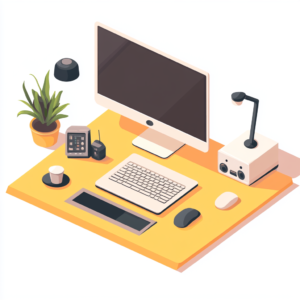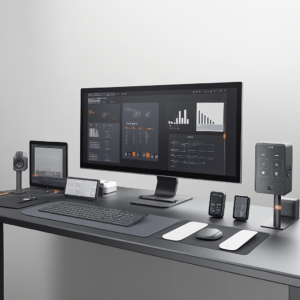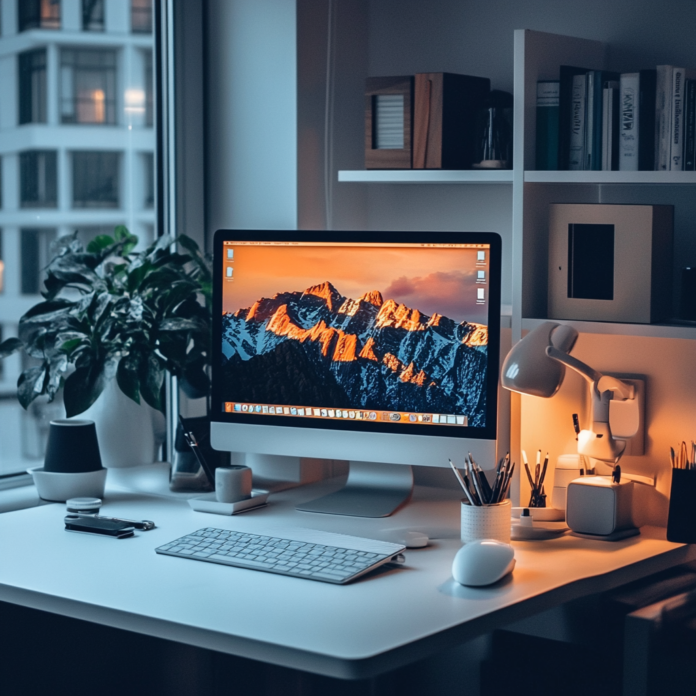1. Introduction
Welcome to my comprehensive exploration of How to Optimize Your work-from-home tech setup. In this guide, I share personal insights, expert tips, and detailed strategies to help you create a highly efficient, comfortable, and secure workspace at home. As remote work becomes a standard practice, it is essential to fine-tune your tech setup for enhanced productivity, seamless connectivity, and overall well-being. Whether you are new to remote work or a seasoned professional looking to upgrade your system, this article will empower you with the knowledge and tools needed to maximize your performance in 2025 and beyond.

Today’s work-from-home environment demands a robust, flexible tech setup that can handle diverse tasks—from virtual meetings and data analysis to creative work and collaboration. In this article, we will cover everything from selecting the right hardware and optimizing your network to ensuring ergonomics and security. Let’s dive into How to Optimize Your work-from-home tech setup and discover the best practices to create an ideal remote work environment.
2. Assessing Your Current Setup
Before making any upgrades, it’s important to evaluate your existing work-from-home tech setup. Begin by taking stock of your current devices, network performance, and workspace ergonomics.
Analyzing Hardware and Software
Review your computer, peripherals, and connectivity options. Identify any bottlenecks in performance or outdated equipment that may be hindering your productivity. Creating an inventory will help you understand what needs to be replaced or upgraded. Make sure to check if your devices support the latest software updates and security patches.
Identifying Pain Points
List the challenges you face while working from home, such as slow network speeds, uncomfortable seating, or distractions. Understanding these issues is the first step in implementing targeted improvements. This self-assessment is a critical part of How to Optimize Your work-from-home tech setup.
Setting Goals for Improvement
Define clear objectives for your upgraded setup. Whether it’s boosting productivity, enhancing comfort, or improving security, having specific goals will guide your upgrade decisions. Consider both short-term fixes and long-term investments that align with your professional and personal needs.
3. Choosing the Right Hardware
Upgrading your hardware is one of the most effective ways to optimize your work-from-home environment. The right equipment can dramatically improve performance, reliability, and overall user experience.
Selecting a High-Performance Computer
Choose a computer that meets your work demands. If you deal with resource-intensive tasks like video editing, 3D rendering, or complex data analysis, invest in a high-end desktop or laptop with a powerful CPU, ample RAM, and a fast SSD. For general office tasks, a mid-range machine may be sufficient. When evaluating options, consider benchmarks and expert reviews from reputable sites like CNET Tech.
Upgrading Peripherals
Invest in quality peripherals that enhance your workflow. A high-resolution monitor with accurate color reproduction is essential for tasks that require detailed visuals. Ergonomic keyboards and mice reduce strain during long work sessions. Additionally, a reliable webcam and microphone are critical for clear virtual meetings. Look for reviews on sites such as Tom’s Hardware for insights on the best peripherals.
Integrating Dual Monitors
Using a dual monitor setup can significantly boost productivity by allowing you to multitask efficiently. With one screen dedicated to primary work and the other for reference or communication, you can manage your tasks more effectively. This hardware upgrade is a key component of How to Optimize Your work-from-home tech setup.
Image Integration
Consider a visual representation of your ideal workspace.

4. Optimizing Your Network and Connectivity
A fast and stable internet connection is the backbone of any successful work-from-home setup. Optimizing your network ensures smooth communication, efficient data transfer, and minimal downtime.
Upgrading Your Internet Plan
Ensure that your internet plan meets your work demands. For video conferencing, cloud-based applications, and large file transfers, consider plans offering higher bandwidth and lower latency. Contact your provider for the latest options available in your area.
Enhancing Wi-Fi Performance
Optimize your home Wi-Fi by placing your router in a central, unobstructed location. Consider upgrading to a router that supports Wi-Fi 6 or 6E for faster speeds and better device management. For more detailed advice, visit CNET’s Networking Section.
Using Wired Connections
Whenever possible, use Ethernet connections to ensure maximum stability and speed. Wired connections eliminate the variability of Wi-Fi and are especially beneficial for critical tasks such as video calls and large file uploads.
Utilizing Network Security Tools
Secure your network by using firewalls and VPNs. A VPN encrypts your connection, protecting sensitive data while working remotely. This is vital for maintaining a secure work-from-home environment.
5. Ergonomics and Workspace Design
Creating a comfortable and efficient workspace is essential for sustaining productivity and preventing physical strain. Ergonomics should be a priority when optimizing your work-from-home tech setup.
Ergonomic Furniture
Invest in a quality ergonomic chair that supports proper posture. A desk at the correct height can reduce the risk of back and neck pain. Adjustable desks that allow you to alternate between sitting and standing are also a great addition.
Monitor Placement and Lighting
Position your monitor at eye level to minimize neck strain. Ensure that your workspace is well-lit, preferably with natural light. Adjustable lighting options can reduce glare and eye fatigue, enhancing overall comfort.
Cable Management and Clutter Reduction
An organized workspace not only looks professional but also improves efficiency. Use cable ties, clips, and organizers to keep your workspace tidy and free of tangled wires. A clutter-free environment promotes better focus and contributes to a more productive setup.
Personalization and Aesthetics
A well-designed workspace reflects your personal style and can inspire creativity. Consider adding elements such as artwork, plants, or a motivational poster. This personalized touch makes your workspace inviting and comfortable.
6. Essential Software and Productivity Tools
Optimizing your work-from-home tech setup is not only about hardware—it’s also about using the right software and productivity tools.
Productivity Suites and Office Software
Ensure that your computer is equipped with a reliable productivity suite. Tools like Microsoft Office 365 or Google Workspace provide essential applications for document creation, spreadsheets, and presentations. These tools are the foundation of How to Optimize Your work-from-home tech setup.
Task Management and Collaboration Tools
Project management applications such as Asana, Trello, or Monday.com help organize tasks and track progress. Collaboration tools like Slack or Microsoft Teams facilitate effective communication with colleagues. These apps streamline your workflow and enhance productivity.
Automation and Scheduling Software
Use automation tools to handle repetitive tasks, schedule meetings, and manage emails. Software like Zapier or IFTTT can integrate multiple apps to automate workflows, saving you time and reducing manual effort.
Security and Backup Applications
Install antivirus software, backup solutions, and data encryption tools to protect your work and sensitive information. Regular backups ensure that your data remains safe in case of system failures or cyberattacks.
For additional insights on productivity software, please check out our internal article AI in Everyday Life: Practical Applications You Need to Know.
7. Security and Data Protection Measures
Securing your work-from-home tech setup is critical for protecting your personal and professional data. Implementing robust security measures ensures that your digital environment remains safe.
Device Security
Enable features like biometric authentication, strong passwords, and two-factor authentication (2FA) on all your devices. Keep your operating system and software up to date with the latest security patches.
Network Security
Secure your home network by changing default router settings, using strong encryption (WPA3), and installing firewall software. A VPN can provide an extra layer of security when accessing public or unsecured networks.
Data Backup and Recovery
Regularly back up your data using reliable cloud services or external drives. Establish a routine backup schedule to ensure that you can quickly recover your information in case of hardware failure or security breach.
Privacy Settings and Software
Review the privacy settings of all installed software and applications. Limit permissions to only what is necessary for each app’s functionality. These practices are crucial for maintaining data integrity and are an integral part of How to Optimize Your work-from-home tech setup.
8. Energy Efficiency and Sustainability
A sustainable tech setup not only reduces environmental impact but can also lead to cost savings over time. Optimizing energy efficiency is a key consideration in modern work-from-home environments.
Energy-Efficient Hardware
Choose devices and components that are designed to consume less power while delivering high performance. Energy-efficient monitors, CPUs, and peripherals help reduce overall energy consumption.
Smart Power Management
Implement smart power management practices such as setting sleep modes, automatic shutdowns, and optimizing screen brightness. These measures extend the lifespan of your devices and lower your electricity bills.
Sustainable Practices
Consider using eco-friendly materials and recycling old hardware. Sustainable practices are becoming increasingly important in the tech industry and are a key factor in How to Optimize Your work-from-home tech setup.
9. Integrating Smart Home Devices
Smart home devices can greatly enhance your work-from-home experience by automating routine tasks and improving overall comfort.
Home Automation Systems
Integrate smart home systems such as Google Home or Amazon Alexa to control lighting, temperature, and security. These systems allow you to manage your environment with voice commands or mobile apps, adding convenience to your workspace.
Smart Security Cameras and Doorbells
Enhance your home security with smart cameras and doorbells that offer remote monitoring and alerts. This not only protects your home but also provides peace of mind while you focus on work.
Seamless Device Integration
Ensure that your smart devices are compatible with your primary work setup. Seamless integration allows for centralized control and better management of your digital ecosystem, further streamlining your work-from-home experience.
10. Future Trends in Work-from-Home Technology
The future of work-from-home technology promises even greater advancements in productivity, connectivity, and user experience. As trends continue to evolve, staying informed will help you maintain a competitive edge.
AI-Driven Productivity Enhancements
Future innovations will leverage AI to further streamline tasks and offer personalized productivity solutions. Intelligent scheduling, real‑time performance analytics, and predictive maintenance are on the horizon, all designed to optimize your work environment.
Expanded Connectivity and Remote Collaboration
Advancements in network technology, including 5G and Wi‑Fi 6E, will enable even more reliable and faster connectivity. Enhanced virtual collaboration tools, including augmented reality (AR) meetings and immersive workspaces, will redefine remote teamwork.
Sustainable and Modular Designs
Future tech setups will focus on sustainability and modularity. Devices that are easy to upgrade, repair, and recycle will become the norm, ensuring that your work-from-home environment is both efficient and eco‑friendly. These emerging trends are an integral part of How to Optimize Your work-from-home tech setup for future challenges.
For more information on emerging trends, visit TechCrunch for the latest news and insights on remote work technologies.

11. Internal and External Resources
Throughout this article, I have integrated insights from various related topics on VikingBytes.com. For further reading on technological innovations and comprehensive reviews, please explore our articles on How AI is Revolutionizing Tech: Trends and Innovations and AI in Everyday Life: Practical Applications You Need to Know. Additionally, external sources such as CNET Tech, Tom’s Hardware, and Wired offer expert opinions and detailed analyses on the latest devices. I also recommend watching the YouTube video “Optimizing Your Work-from-Home Tech Setup 2025” for a visual guide that complements this article.
12. Frequently Asked Questions (FAQ)
Q1: What should I consider when upgrading my work-from-home tech setup?
A: Prioritize performance, connectivity, and ergonomics. Evaluate hardware compatibility, network speed, and workspace comfort to ensure an efficient and reliable setup.
Q2: How can I improve my home network for remote work?
A: Invest in a high-speed internet plan, upgrade your router to a model that supports Wi-Fi 6, and use Ethernet connections where possible to ensure stable connectivity.
Q3: What are the best practices for securing a work-from-home tech setup?
A: Use strong passwords, enable two-factor authentication, regularly update software, and secure your network with VPNs and firewalls.
Q4: How can I ensure my devices are energy efficient?
A: Choose energy‑efficient hardware, set up smart power management features, and regularly maintain your devices to optimize performance and reduce power consumption.
Q5: What future trends will impact work-from-home technology?
A: Emerging trends include AI‑driven productivity enhancements, advanced connectivity through 5G and Wi‑Fi 6E, immersive collaboration tools, and sustainable, modular device designs.
13. Conclusion
Summary of Key Points
In conclusion, optimizing your work-from-home tech setup is essential in today’s digital era. This guide has covered key areas such as hardware upgrades, network optimization, ergonomic workspace design, essential software tools, and robust security measures. By understanding these elements, you can create a productive and comfortable environment that supports your professional and personal needs.
Final Thoughts
As remote work continues to evolve, staying ahead of emerging trends and continuously refining your setup will ensure that you remain efficient and competitive. Thank you for reading this comprehensive guide on How to Optimize Your Work-from-Home Tech Setup.
14. Calls to Action and Affiliate Recommendations
If you’re ready to take your AI experience to the next level, I invite you to check out this tool that helps you create content by easily creating realistic digital models of people from simple descriptions and exploring the potential of artificial intelligence in digital art. Check it out here.
